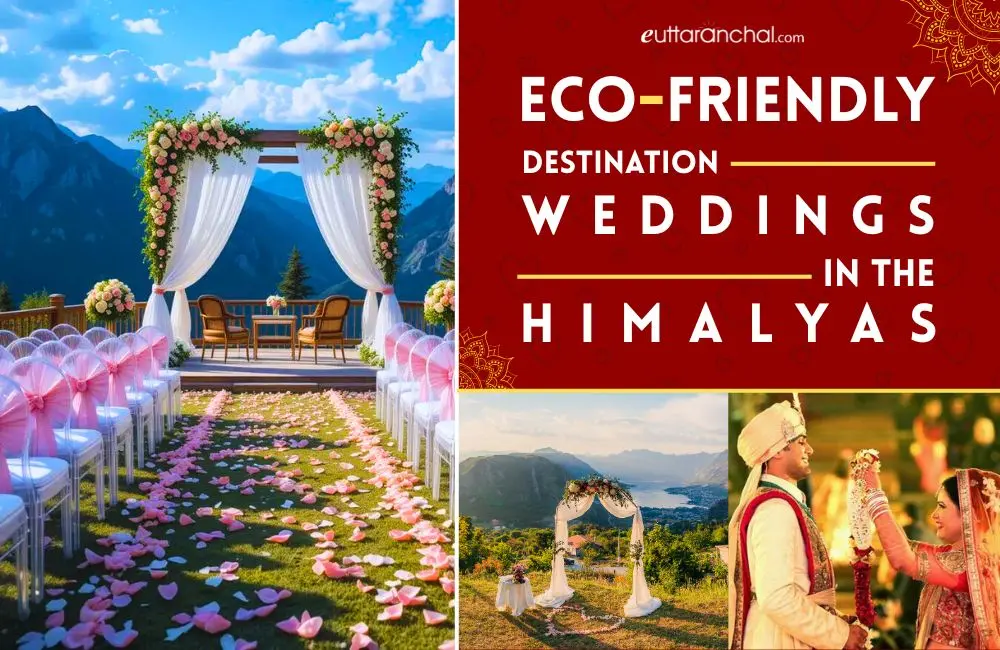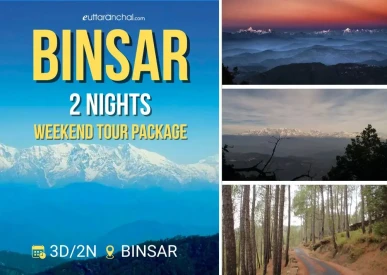Eco-Friendly Destination Weddings in the Himalayas

Couples are showing increasing interest in destination weddings in the Himalayas, which are sustainable and not harmful to the environment. The Himalayas offer natural beauty, mountain air, rivers, forests and a remote location, making wedding celebrations memorable and intimate. Over the last few years, numerous wedding planners and couples have attempted to organize weddings in this area in a manner that also minimises the environmental impact. It is important not to focus on having a memorable wedding but also to be sensitive to the delicate mountain ecosystems and the local people.
With the expansion of the wedding tourism industry, this harmony between natural beauty and environmental responsibility is becoming increasingly popular. Reports estimate the destination wedding market of India to increase manifold in the coming few years, and indicate the rising demand for immersive and theme-based weddings, which cover sustainable weddings as well.
This article will take you through the trends of eco-friendly destination weddings in the Himalayas, practices being embraced, venue selection, the challenges involved, and how a guide for couples can organise an eco-friendly wedding in the mountains.
Why the Himalayas Are Ideal for Eco-Friendly Weddings
The Himalayas are distinct in terms of hosting environmentally friendly wedding ceremonies. The region's forest cover, rivers, hill trails, alpine meadows and remote villages are natural decor. Most of the venues are in low-pollution neighbourhoods, with clean air and rich natural scenery. Since these locations are less urbanised, it is possible to collaborate more with local craftspeople, local food, and local materials.
Moreover, communities in the Himalayan region tend to rely on natural resources to make a living, and, therefore, the arrangement of weddings (e.g., acquiring flowers, dishes, or accommodation) may serve the needs of local economies and contribute to sustainability.
Latest Trends in Eco-Conscious Weddings Across India
Some trends have emerged in the past few years in how weddings are held sustainably in India. Such practices not only lower transport emissions but also favour local businesses and, in some cases, assist in lowering costs. Certain establishments in Himalayan regions also market eco-luxury where comfort is ensured, but resource conservation, such as water, energy consumption and waste management, is employed. Some places exist where renewable energy or solar power is utilized and basic services are provided. Most destination wedding reports do contain eco-friendly choices as part of package trends.
- Increasing numbers of couples are adopting vegan or plant-based menu options to limit the environmental impact of meat, dairy, and food waste.
- Most couples prefer biodegradable or reusable pieces of decoration, such as seed paper to send wedding invitations, and single-use plastics, which are avoided.
- Forest weddings are gaining popularity with couples choosing natural environments instead of banquet halls and big indoor spaces to save on energy consumption and travel within the venue.
- Local sourcing of flowers, food, decor items, and the use of local craftspeople is another trend.
Popular Eco-Friendly Wedding Venues in the Himalayas
A number of destinations within or close to the Himalayas also offer sustainable or environmentally-conscious weddings, or at least have the capacity to do so based on their location, facilities or policies. For example,
- Himalayan Ganga Retreats in Rishikesh provides retreats by the river, with local decor, and strives to respect their environment in the product.
- Tethys Himalaya, which owns Norkanda and Kasauli Hills, encourages weddings in forest-themed locations, lawns, and forest-like locations, which enable couples to limit the use of artificially controlled indoor areas.
- The other example is The Pavilions Himalayas, whose philosophy is eco-luxury: the villas will be powered by renewable energy, the produce will be made on their organic farm, and they will strive to make their environmental footprint less harmful.
- In addition, in Jim Corbett, a lot of the locations, such as Aahana - The Corbett Wilderness and WelcomHotel by ITC in Corbett, are located in natural vegetation (sal forests, river views), and the venues are more readily accommodating of greener practices than in urban wedding halls.
Green Wedding Practices and Sustainable Activities
Most ecofriendly weddings in the Himalayas are characterized by the decisions that minimize environmental destruction.
- Waste management is one of them: organisers increasingly design their events to omit single-use plastics, have organic waste properly disposed of or composted, minimise the use of non-biodegradable materials in decorating, and donate food leftovers.
- The other one is conservation of energy and water. The venues may install solar panels, LED lighting, harvested rainwater, or reuse water sustainably.
- Transport is another point of discussion: the selection of venues that should be comparatively accessible, assistance in organizing collective transports among guests, utilizing local transport, minimization of traveling distances.
- The use of local materials in decoration, i.e. not bringing in flowers, wood, fabrics, etc., from far away, is not only environmentally-friendly, but also contributes to a decrease in carbon footprint.
- Most couples choose to keep the surroundings very simple, with the natural environment as the setting.
- Menus tend to focus on seasonality, organic farm food, and occasionally even vegetarian or partially vegetarian menus.
- Clothing is also changing a little: handmade fabrics, vintage or hired out clothes, natural dyes and keeping excessive changes of costume to a minimum. It is all these little things.
Challenges of Hosting Eco-Friendly Weddings in the Mountains
Despite good planning and a strong will, there are issues.
- One is that most Himalayan destinations' delicate ecology implies that the permissions are strict; specific locations cannot be loaded with visitors, or the logistics can damage soil, vegetation, or wildlife.
- Permission to use drones, music, light and power backup can be more difficult. Second, the cost and carbon foot print of transporting goods, decor, food and people to remote mountain venues is usually high particularly when the roads are rugged.
- Third, unpredictability of weather and the terrain complexity complicates the organisation of logistics: power supply cannot be stable, outdoor events are subject to weather conditions, rain or snow, and indoor areas are small.
- Fourth, striking a balance between the comfort of the guests and their environmental impact is a delicate one--guests must have proper facilities (clean water, toilets, shelter) but not too much garbage on the site.
- Lastly, lots of local sellers are yet to integrate environmentally friendly demands; say, organic food or biodegradable substances might be more expensive or more difficult to find in isolated localities.
How to Plan an Eco-Friendly Wedding in the Himalayas
Those couples, interested in organizing their wedding in the Himalayas to be environmentally friendly, must plan thoroughly.
- Another factor that needs to be considered is picking a venue that already has sustainable policies. Inquiries about the waste management, the energy sources, use of water, local sourcing, accommodation impact and transport of the guests would prevent any surprises.
- It is preferable to reduce the number of guests or merge events in fewer locations to ensure that travel and resource consumption are kept to a minimum.
- Local decor materials, local artisans and local food suppliers make it not only sustainable but also prosperous in the story of the wedding. Using seasonal flowers and foods lessens the carbon footprint.
- The alternative is using digital invitations instead of paper or seed paper cards. In terms of decor, it is better to use reusable, biodegradable or minimal objects (wood, fabric, clay) instead of using plastics and imported decor.
- To avoid transportation issues, it is important to plan the transportation-group shuttles and communal transportation of guests, as well as anticipation increase in arrivals by road instead of several small flights.
- Energy and weather (generators, indoor venue) backup plans are necessary, but they must be chosen with environmentally friendly options whenever feasible (e.g., clean fuel).
Lastly, it is crucial to collaborate with wedding planners who are aware of sustainable practices and local ecology: they can assist with permits, selection of vendors, waste management, and make sure the event does not damage the site.
Balancing Luxury with Sustainability
Eco-friendliness does not necessarily imply sacrifices of comfort. Lots of places in the Himalayas are exploring methods of providing luxuries without compromising sustainability. Examples are resorts that are lit or heated by renewable energy, lodges with water recycling arrangements, or even boutique properties that reduce waste production by providing refillable toiletries to guests instead of disposable ones.
Several luxury wedding packages are now offered with optional green extras: like locally sourced decor, seasonally-friendly and plant-based menus or a sustainably-friendly wedding favour (seed packets, locally crafted handicrafts). Photograph and video services are also shifting gears towards battery-powered drones, LED lighting, and light rigs with minimal lighting to minimize the use of energy.
By so doing, couples will be able to carry on with dignified destination weddings in Himalayas without a huge environmental price.
Conclusion: Celebrating Love While Preserving Nature
More and more couples are concerned with climate, ecosystems, and sustainability, so weddings in Himalayan regions are planned with the minimum impact. Waste minimization, sourcing locally, using environmentally friendly decor, conserving energy, handling guests' traveling, and selecting a place to hold the event with a sustainable policy are becoming more popular.
Despite the existing challenges, such as permissions, costs, logistics, and assurance of the comfort of guests, it is possible to organize beautiful and responsible weddings with proper planning and the choice of partners. The trends and options that are emerging today make it possible to have a destination wedding in the Himalayas and leave a light footprint.



















